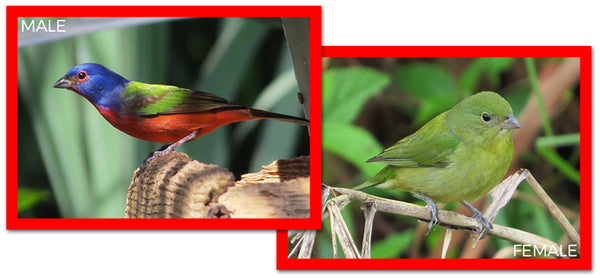

SCIENTIFIC NAME: Passerina Ciris

Males have a dark blue head, green back, red rump and underparts.
Females and juveniles are green and yellow-green.
Juveniles have two inserted molts in their first autumn, each yielding plumage like an adult female.
The first starts a few days after fledging, replacing the juvenile plumage with an auxiliary formative plumage; and the second a month or so later giving the formative plumage.

BILL: grayish, cone-shaped.
SIZE: measures about 4.7 - 5.5 inches in length, with a wingspan of 8.3 - 9.1 inches.
WEIGHT: weighs about 13 - 19 grams.
COLOR: yellow-green, green, red, reddish-brown, and buff.

Grass seeds, including; Panicum, Amaranthus, Oxalis, Euphorbia and Carex during winter; small invertebrates, including; spiders, snails, grasshoppers, caterpillars and other insects while breeding.

Bushy and weedy fields, woodland edges, streamside brush, arid to semi-humid, semi-open areas with edges and recently abandoned farmland.
Winters in shrubby pastures, forest edges and clearings and other similar habitats.

Along the Atlantic coast from North Carolina to North Central Florida.
It winters in Florida, Bahamas and sometimes Cuba.

CALL: A sharp “chirp” or a loud, rich “chip”, also “plik” or “pik-pik-pik”.
SONG: A rapid series of varied phrases, a musical series of notes, and a rich warbler.
Only the male sings.

NEST: The female builds a cup-shaped nest made of grass stems, rootlets and bark strips, lined with moss and hair.
EGGS: 3 - 4 bluish-white to grayish-white eggs with dense darker markings.
INCUBATION: 12 - 14 days, female.

They forage on the ground in dense cover, among grasses, or at seed feeders. Sometimes they venture out into grass to forage on seeds.
During migration, they form loose flocks with other seed-eating birds.
The breeding males often perch out in the open to sing their jumbled, sweet songs.

The oldest recorded wild Painted Bunting was at least 12 years old.

